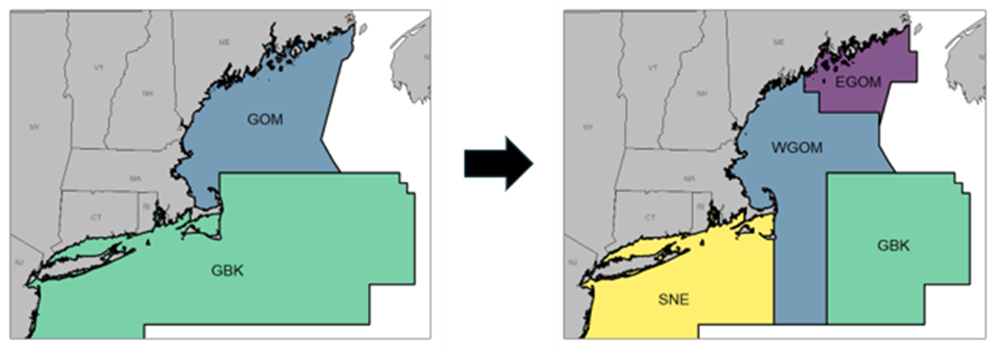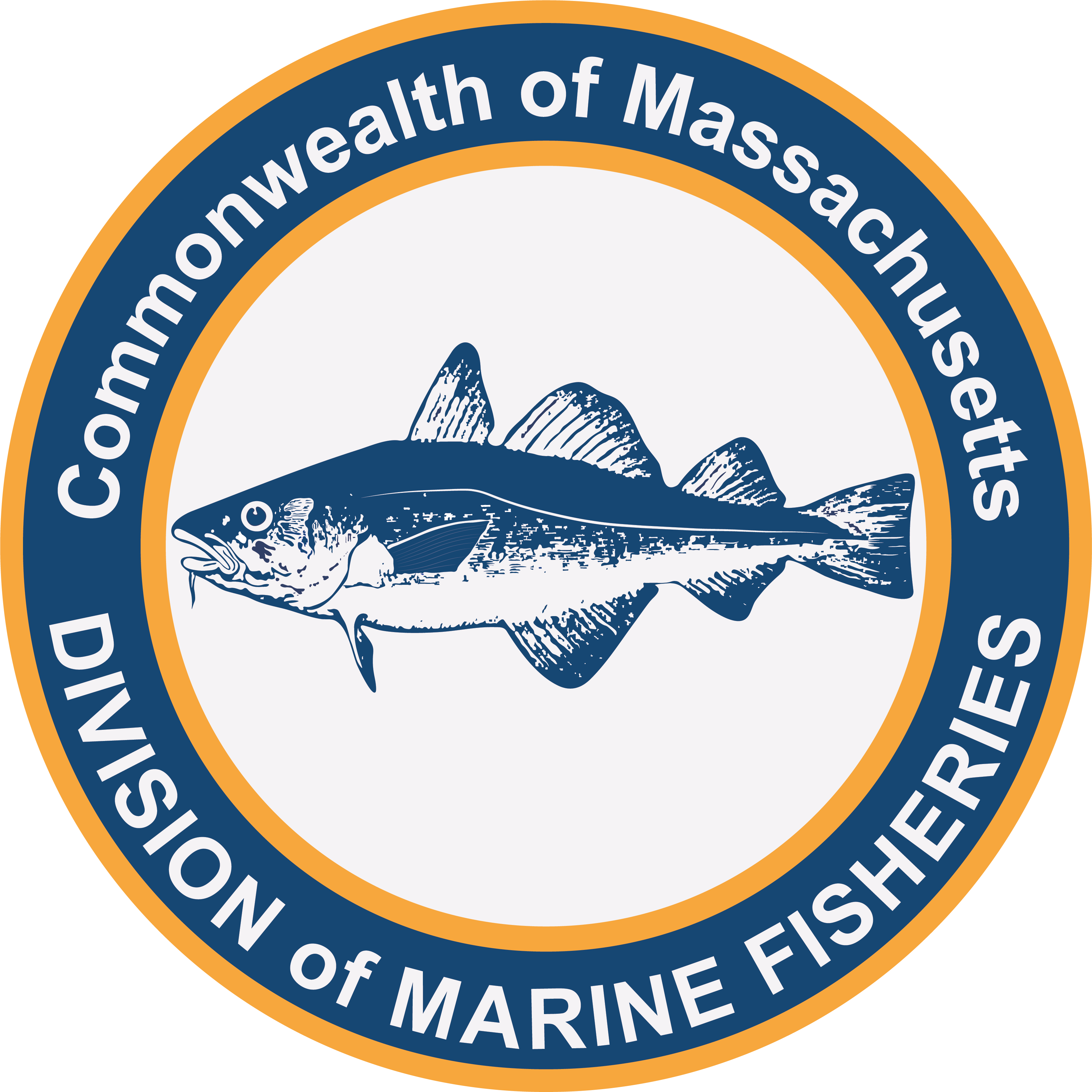- Division of Marine Fisheries
Atlantic cod has been a cornerstone of New England’s fishing heritage, sustaining vibrant and economically significant fisheries in Massachusetts. Historically managed as two biological units—Gulf of Maine (GOM) and Georges Bank (GBK)—new research has revealed greater complexity in cod populations. A 2023 Research Track Stock Assessment (a periodic update to the science and methodology of stock assessments) confirmed that Atlantic cod in U.S. waters consist of five biological populations, later consolidated into four stocks: Eastern Gulf of Maine (EGOM), Western Gulf of Maine (WGOM), Georges Bank (GBK), and Southern New England (SNE). This new understanding marks the beginning of the Atlantic Cod Management Transition, a process aimed at aligning management with the best available science.
The Cod Management Transition Plan, developed by the New England Fishery Management Council (NEFMC), will occur in two phases. Phase One, beginning in 2025, incorporates the four new stock units into the Fishery Management Plan, establishes criteria for determining the status of stocks, and sets catch limits for fishing years 2025–2027. Phase Two, slated to begin in 2027, will introduce long-term measures, including adjusted quota allocations (the portion of the total allowable catch that a user group is permitted to catch) and enhanced protections for spawning cod. The fishing year beginning May 1, 2025 will see catch limits from four cod stock assessments apportioned into the old system of two management units. This change is temporary until Phase Two, when allocations will align with the new management units.
This transition has significant implications for fishery participants, particularly in Massachusetts which has historically harvested cod from both old stock units. Massachusetts ranks in the top two ports for commercial fishing revenue for all new cod stocks, except SNE. From 2019–2023 Gloucester and New Bedford alone accounted for 89% and 65% of cod landings from GBK and WGOM, respectively.
The new understanding of cod stocks highlights their declining populations, necessitating quota reductions. The reductions present challenges for fishers, as they limit opportunities to target other valuable groundfish species that co-occur with cod. To mitigate economic hardship, DMF is collaborating with industry partners to pursue temporary exemptions to certain closed areas for 2025. If approved, these exemptions would allow limited access to non-cod groundfish, while gathering critical data for refining spawning closures in future management actions.
Phase One of the Cod Transition coincides with reductions in cod quotas starting May 1, 2025, the first year where catch limits were based on the four new cod stocks. These reductions were informed by the 2024 Management Track Stock Assessments (routine assessments that produce catch advice) and reflect the challenges of updating our understanding of cod populations, notably that it is not accurate to compare fishery information (biology, catch history, management) between the new system (four stocks) and the old system (two stocks).
The 2024 Management Track Stock Assessments were also the first time catch advice for cod was produced using the Woods Hole Assessment Model (WHAM). WHAM is a technical improvement over past modeling frameworks, able to separate variability in data collection from variability in the biological processes being modeled. WHAM can incorporate environmental covariates, such as temperature, in a way which changes over time, allowing it to capture how changing conditions affect fish population dynamics. These features, among others, make WHAM adaptable to complex ecological and management scenarios, providing a more nuanced understanding of fish stocks. However, the flexibility of WHAM creates decision points where options must be carefully evaluated for sensitivity of the model results to different choices. Scientific and stakeholder expertise are critical to informing modeling decisions that are biologically accurate and make the best use of the available data. The 2023 Cod Research Track Stock Assessment, a collaborative effort between state, federal and academic partners, synthesized decades of research and expert opinions to inform these decisions.
DMF plays a critical role in cod stock assessments by providing essential data, conducting targeted research, and actively contributing to assessment processes. Through our recently enhanced port sampling program, DMF measured 683 commercially landed cod and collected otoliths (structures in fish ears which can be used to determine age) from 333 of them, in 2024 to date, to address critical data deficiencies. DMF staff survey anglers to characterize recreational fishing effort, participate in research track assessments, and serve on groundfish management bodies. DMF continues to advocate for integrating diverse data sources into assessments, such as our annual Resource Assessment Survey which has provided data on cod abundance and distribution in underrepresented inshore areas dating back to 1978. DMF conducts original research to fill key knowledge gaps in stock assessments and fishery management as well as to protect spawning cod. In particular, the Cod Industry-Based Surveys, conducted in collaboration with industry partners from 2003–2007 and 2016–2019 were crucial to informing the 2022 review of cod stock structure, the 2023 Research Track Stock Assessment, and spatial protection measures. Going forward, these efforts will facilitate the transition to a more accurate understanding of cod stocks and sustainable management in the region.
Despite the immediate challenges, this transition represents an essential step toward better aligning cod management with biological realities. By addressing the unique characteristics of each stock, these efforts aim to rebuild Atlantic cod populations and sustain one of Massachusetts’ most iconic fisheries.
By Tara Dolan, PhD, Fisheries Biologist

